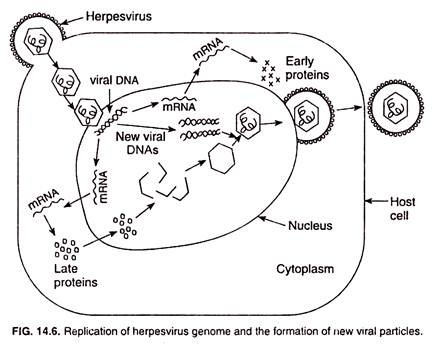
Virus replication:
- Virus are the obligate intra cellular particles, they replicate inside host cell only.
- For a specific virus to replicate within a
specific host cell, certain condition must be fulfilled. Some of the criteria
that are required to be fulfilled in order to viral replication are;
- The host cell must be permissive and the virus must be compatible to host cell.
- The host cell must not degrade the virus.
- The viral genome must possess the information for multiplying utilizing the normal metabolism of host cell.
- The virus must be able to use the metabolic capability of host cell to produce new progeny virus particles containing replicated copy of viral genome.
- A cell within which virus replicates is called host cell. Therefore the host may be permissive or non-permissive.
- Those host cell within which virus replicates is called permissive or compatible host cell and those within which virus cannot replicate is called non-permissive or non-compatible host cell.
- The host cell range of a virus is defined by the types of cells within which replication of that particular virus occurs.
- Some virus have broad host range and can replicates within several types of host cell whereas other virus have narrow host range.
Outcome of virus replication:
Virus replication of host cell can have three possible outcomes.
i. Productive infection:
- It occurs in permissive cell which results in viral replication within it producing progeny viruses that can infect other compatible host cells.
- The complete infectious virus produced in such infection is called virions.
ii. Abortive infection:
- It occurs in non-permissive host cell so that virus replication does not occurs or because virus replication produces viral progeny that are incapable of infecting other host cell.
iii. Restrictive infection:
- It occurs when host cell is transiently permissive so that infective viral progeny are sometime produce and other time the virus persists within cell without production of infective viral progeny.
- It results in occasional release of virus with no cell death.
Stages of virus replication:
- Although the specific detail of virus replication vary from one virus to another, general replication is same for most virus.
- The stages includes;
- Attachment of virus to outer surface of suitable host cell; a process called Adsorption
- Penetration of virus into host cell
- Release of viral genome from capsid; a process called un-coating that sometime occurs simultaneously with penetration)
- Synthesis of viral proteins
- Synthesis of viral genome
- Assembly of viral progeny (virion)
- Release of progeny virus from host cell.
i. Attachment (Adsorption):
- This is the first step in virus infection in which interaction of virion with a specific receptor site on the surface of host cell occurs.
- The receptors sites are normal cell surface components of host cell such as protein, polysaccharides or lipoprotein-polysaccharide complex to which virus attach.
- For eg. HIV binds to CD4 cell receptor of
T-lymphocytes
- Rhinovirus binds to ICAM-1
- Epstein Barr virus binds to C3 complement receptor.
- Each host cell contains upto 100,000 receptor sites for a given virus.
- In general viral receptor carryout normal function in cell.
- For eg. In some bacteriophage, receptor are pilli and flagella and in other virus receptor site may be transport binding protein etc.
- Receptor of influenza virus is glycoprotein found in RBC and on other cell of mucus membrane of susceptible host.
ii. Penetration:
After binding of virus, virus is taken up inside the cell which is referred as penetration or engulfment.
- The entry of virus into host cell may involves;
- Transfer of only genome across cytoplasmic membrane
- Transport of entire virus across cytoplasmic membrane by endocytosis
- Fusion of viral envelope with cytoplasmic membrane of host cell.
iii, Uncoating;
- Shortly after penetration, uncoating of virus take place.
- Uncoating is defined as release of viral genome from capsid and is accessible to enzymes required to translate, transcribe and replicate it.
- The uncoating process vary from virus to virus.
- Transcription of viral genome is usually the next step in all virus except in those virus whose genome acts directly as mRNA (eg. Picorna virus).
- RNA viruses that carry minus(-) stranded RNA first transcribe their DNA to plus (+) stranded RNA that function as mRNA.
- The transcription is catalyzed by viral RNA polymerase released during uncoating.
iv. Biosynthesis:
- The biosynthesis process of virus replication can be divided into early event and late events.
- Early event:
- In most virus, only part of nucleic acid is initially transcribed into mRNA.
- The early mRNA codes for early proteins (enzymes) required for nucleic acid replication
- After nucleic acid replication, many copy of progeny nucleic acids formed.
- Late event:
- Late mRNA is transcribed from progeny genome.
- Late mRNA codes for structural proteins by the process of translation. The translation process always occurs in cytoplasm of host cell, even if the mRNA synthesized in nucleus, it enter cytoplasm for translation.
v. Assembly:
- When critical number of various viral components have been synthesized, they assembled into mature virus.
- The assembly occurs in nucleus or cytoplasm of host cell depending upon types of virus.
- DNA virus assembled in nucleus except Poxvirus and RNA viruses assembled in cytoplasm except Influenza virus and Reo virus.
vi. Release:
- Release of mature virus from host cell is the final event in virus replication.
- The mechanism of virus release vary with types of virus.
- The naked viruses are generally released by cell lysis.
- The enveloped viruses are released by budding through special area of host cell membrane; during which virion acquire a portion of host cell membrane.
- In some animal and plant virus, host cells are not killed, the virus release through special channels.
For example: Replication of Herpes simplex virus

